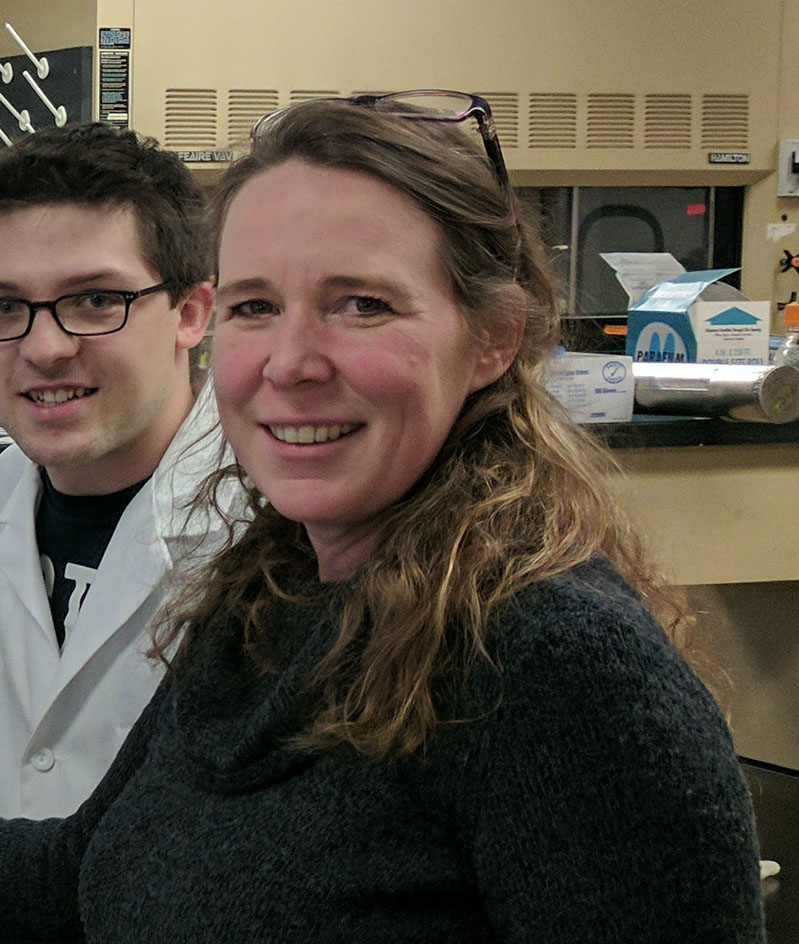| Faculty Profile |
|
Department
Biological Sciences
Phone
313-577-9241
Fax
313-577-6891
Office
4115 Biological Sciences Building
Selected publications
- McLaughlin M, Higgs PI. Mutation of self-binding sites in the promoter of the MrpC transcriptional regulator leads to asynchronous Myxococcus xanthus development. Front Microbiol. 2023 Nov 23;14:1293966. doi: 10.3389/fmicb.2023.1293966. PMID: 38075919; PMCID: PMC10701913.
- Muñoz-Dorado J, Moraleda-Muñoz A, Marcos-Torres FJ, Contreras-Moreno FJ, Martin-Cuadrado AB, Schrader JM, Higgs PI, Pérez J.Transcriptome dynamics of the Myxococcus xanthus multicellular developmental program. Elife. 2019;8:e50374. Published 2019 Oct 14. doi:10.7554/eLife.50374
- McLaughlin PT, Higgs PI. A negative autoregulation network motif is required for synchronized Myxococcus xanthus development. bioRxiv 738716; doi: https://doi.org/10.1101/738716
- Feeley BE, Bhardwaj V, McLaughlin PT, Diggs S, Blaha GM, and P.I. Higgs. An amino-terminal threonine/serine motif is necessary for activity of the Crp/Fnr homolog, MrpC, and for Myxococcus xanthus developmental robustness. (2019) Molecular Microbiology doi: 10.1111/mmi.14378
- Glaser, M., and P.I. Higgs. The orphan hybrid histidine protein kinase, SinK, acts as a signal integrator to fine-tune multicellular behavior in Myxococcus xanthus. (2019) Journal of Bacteriology doi: 10.1128/JB.00561-18
- McLaughlin, P.T., Bhardwaj, V., Feeley, B.E., and P.I. Higgs. MrpC, a CRP/Fnr homolog, functions as a negative autoregulator to control the Myxococcus xanthus multicellular developmental program. (2018) Molecular Microbiology 109(2):245
- Prüβ BM, Liu J, Higgs PI, Thompson LK. Lessons in Fundamental Mechanisms and Diverse Adaptations from the 2015 Bacterial Locomotion and Signal Transduction Meeting. (2015) Journal of Bacteriology 197:3028-40
- Holkenbrink C, Hoiczyk E, Kahnt J, and P.I. Higgs. Synthesis and assembly of a novel glycan layer in Myxococcus xanthus spores. (2014). Journal of Biological Chemistry. 289:32364-78
- Higgs. P.I., Hartzell, P.L., Holkenbrink. C., and E. Hoiczyk. Myxococcus xanthus vegetative and developmental cell heterogeneity. (2014). In Myxobacteria: Genomics and Molecular Biology. Yang, Z. and Higgs, P.I. (ed.) Horizon Scientific Press, Norfolk, UK. pp. 51-71
- Muñoz-Dorado, J., Higgs, P.I., and M. Elías-Arnanz. Abundance and complexity of signaling mechanisms in the mycobacteria. (2014). In Myxobacteria: Genomics and Molecular Biology. Yang, Z. and Higgs, P.I. (ed.) Horizon Scientific Press, Norfolk, UK. pp. 127-149
- Schramm, A., Lee, B. and P.I. Higgs. Intra- and interprotein phosphorylation between two-hybrid histidine kinases controls Myxococcus xanthus developmental progression. (2012) Journal of Biological Chemistry. 287:25060-72
- Lee, B., Holkenbrink, C., Treuner-Lange, A., and P.I. Higgs. Myxococcus xanthus developmental cell fate production: heterogeneous accumulation of developmental regulatory proteins and reexamination of the role of MazF in developmental lysis. (2012) Journal of Bacteriology.194:3058-68
- Müller, F., Schink, C., Hoiczyk, E., Cserti, E., and P.I. Higgs. Spore formation in Myxococcus xanthus is tied to cytoskeleton functions and polysaccharide spore coat deposition. (2012) Molecular Microbiology. 83:486-505
- Lee, B., Mann, P., Grover, V., Treuner-Lange, A., Kahnt, J., and P.I. Higgs. The Myxococcus xanthus spore cuticula Protein C is a fragment of FibA, an extracellular metalloprotease produced exclusively in aggregated cells. (2011) PLoS One. 6(12):e28968
- Müller, F., Treuner-Lange, A., Heider, J., Huntley, S.M., and P.I. Higgs. Global transcriptome analysis of spore formation in Myxococcus xanthus reveals a locus necessary for cell differentiation. (2010) BMC Genomics. 11:264.
- Lee, B., Schramm, A., Jagadeesan S., and P.I. Higgs. Two-component tems and regulation of developmental progression in Myxococcus xanthus. (2010) Methods in Enzymology Volume 471, Chapter 14, Pages 253-278
- Jagadeesan, S., Mann, P., Schink, C.W., and P.I. Higgs. A novel "four-component" two-component signal transduction mechanism regulates developmental progression in Myxococcus xanthus. (2009) Journal of Biological Chemistry. 284:21435-45.
- Higgs, P.I., Jagadeesan, S., Mann, P., and D.R. Zusman. EspA, an orphan histidine protein kinase, regulates the timing of expression of key developmental proteins of Myxococcus xanthus. (2008) Journal of Bacteriology. 190:4416-26.
- Article highlighted in: Kroos L. Bacterial development in the fast lane. (2008) Journal of Bacteriology. 190:4373-6
- P.I. Higgs, and J.P. Merlie, Jr. Myxococcus xanthus: Cultivation, Motility, and Development. In Myxobacteria: Multicellularity and Differentiation. Whitworth, D. (ed.) (2008) ASM, Press, Washington D.C.
- Stein, E.A., Cho, K., Higgs, P.I., and D.R. Zusman. Two Ser/Thr protein kinases essential for efficient aggregation and spore morphogenesis in Myxococcus xanthus. (2006) Molecular Microbiology. 60:1414&ndash1431
- Higgs, P.I., Cho, K., Whitworth, D.E., Evans, L.S., and D.R. Zusman Four Unusual Two-Component Signal Transduction Homologs, RedC to RedF, Are Necessary for Timely Development in Myxococcus xanthus. (2005) Journal of Bacteriology. 187:8191-8195
Research Description
We are molecular microbiologists with interests in signal transduction, gene regulation, cell fate segregation, and microbial differentiation. Our model organism is Myxococcus xanthus, ubiquitous soil bacteria with a fascinating multicellular lifestyle that includes predation, and a starvation-induiced multicellular developmental program. During development, cells segregate into distinct fates. Some cells are directed to migrate into mounds and then differentiate into spores. Alternate cell fates include programmed cell death, formation of a persister-like state and production of matrix-encased aggregates. Our group uses genetic, biochemical and cell biology approaches to understand how this complex behavior is regulated.
